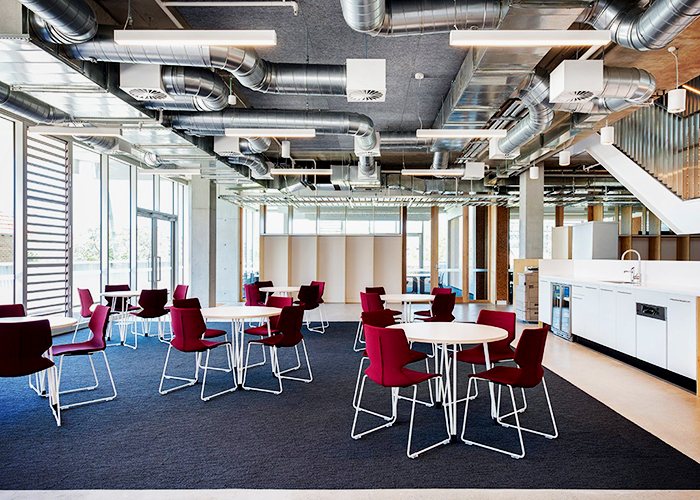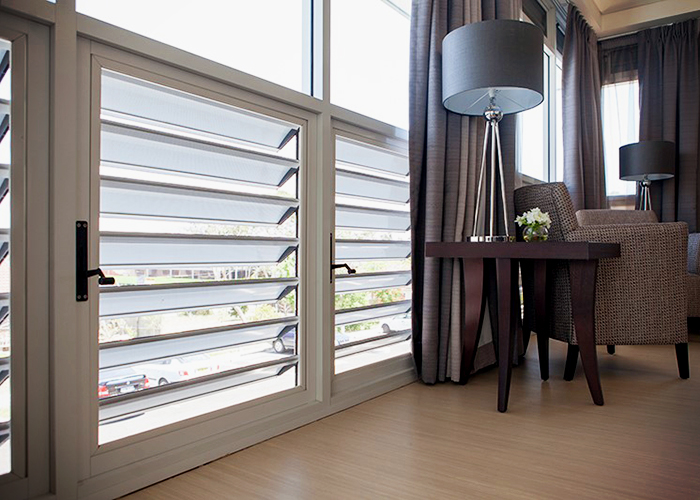Humidity Control of Public Spaces with Louvres by Safetyline Jalousie Why Indoor Humidity Control Regulations are Important in Public Spaces While it is not always apparent, indoor humidity in public buildings plays an important role in health and safety. Whether in a house, strata, restaurant, school, office, or hospital, there is a considerable risk to people's health if there are no regulations in place. Unchecked and unhealthy levels of humidity can worsen asthma and cultivate the growth of mould and dust mites. But more than these, the biggest concern around humidity is the increased risk to viruses, especially at this time of COVID-19. Absence of Humidity Control Regulations Currently there are no definite regulations backed by government agencies on humidity control and indoor air quality in public buildings. Generally speaking, maintaining humidity between 40-60% is both comfortable for people and scientifically known to stop viruses from growing and cross contaminating. Older buildings such as schools, hospitals, and aged care facilities most likely do not have updated measures on humidity levels, exposing their people to health threats that could be avoided. Research has shown that viruses, such as the coronavirus, deactivate at a faster rate on surfaces under mid-range humidity. This important aspect has not been included in any new official humidity control regulations, making people still susceptible to infections. To address this important health issue, building developers and designers are forced to incorporate humidity controls in their building design plans. Seasonal Differences on Humidity Control Humidity control varies per season. If it is too high in the summer, it increases temperature and causes discomfort plus excessive perspiration. In winter, people could develop skin problems and sinus infections from the cold weather if their buildings do not have proper ventilation. Incorrect humidity levels for sustained periods could also lead to more serious respiratory problems. Indoor humidity control depends on the outside temperature. Make sure your air-conditioning, humidifiers, dehumidifiers, and windows are used in ways that are comfortable for people.  Melrose Retirement Village in Pendle Hill utilizes louvres for optimal ventilation and indoor humidity control. Suggestions for Enjoying Optimal Indoor Humidity While there are no official humidity control regulations in place yet, experts have shared their best practices in regulating temperature and humidity for occupants' health:
Most of the time, maintaining proper humidity is as easy as opening a window. When designing public buildings, it is critical to use easily operable equipment that can be used by anyone. Windows are a cost-effective measure to control humidity without driving energy consumption. On the other hand, there are also automated windows that are highly effective in controlling humidity by using air quality sensors. They open and close depending on the humidity, temperature, and CO2 levels of its surroundings. These automated windows can also purge stale air during off-peak hours. The Final Word Managing the humidity and overall quality of indoor air is a must in public buildings. It is the responsibility of building owners and managers to protect the health and well-being of their occupants from the risk of virus spreading indoors. At this time when the coronavirus poses a grave threat to our immune system, better regulations could be a valuable tool in our line of defense. Read our recent case study on the Royce to learn how Safetyline Jalousie louvre windows can assist in improving indoor air quality and humidity control.
|
1300 86 3350 3/11-17 Wilmette Place, Mona Vale NSW 2103
|


 SJ Espacer Large-Format Louvre Windows
SJ Espacer Large-Format Louvre Windows High-Performance Louvres for Modern
High-Performance Louvres for Modern Factors to Consider for Window Safety
Factors to Consider for Window Safety Benefits of Louvre Windows for Coastal
Benefits of Louvre Windows for Coastal Louvre Windows with Weather Seal by
Louvre Windows with Weather Seal by How to Maintain Louvre Windows by
How to Maintain Louvre Windows by Operable Louvre System by Safetyline
Operable Louvre System by Safetyline Louvre Windows for Cyclone-Prone Areas
Louvre Windows for Cyclone-Prone Areas Floor-To-Ceiling Aluminium Louvre
Floor-To-Ceiling Aluminium Louvre Importance of Louvres for Indoor Pools
Importance of Louvres for Indoor Pools Aluminium vs Glass Louvres by Safetyline
Aluminium vs Glass Louvres by Safetyline Louvre Windows for Coastal Properties
Louvre Windows for Coastal Properties Safety Glass for Louvre Windows by
Safety Glass for Louvre Windows by Advantages of Louvre Windows for Schools
Advantages of Louvre Windows for Schools SmartAir System by Safetyline Jalousie
SmartAir System by Safetyline Jalousie SJ Espacer Tested To Australian Standard
SJ Espacer Tested To Australian Standard Safetyline Jalousie's New ArchiCad
Safetyline Jalousie's New ArchiCad Thermally Broken Louvre System by
Thermally Broken Louvre System by Eco Friendly Louvre Windows for Shopping
Eco Friendly Louvre Windows for Shopping Charcoal Framed Louvre Windows at
Charcoal Framed Louvre Windows at
